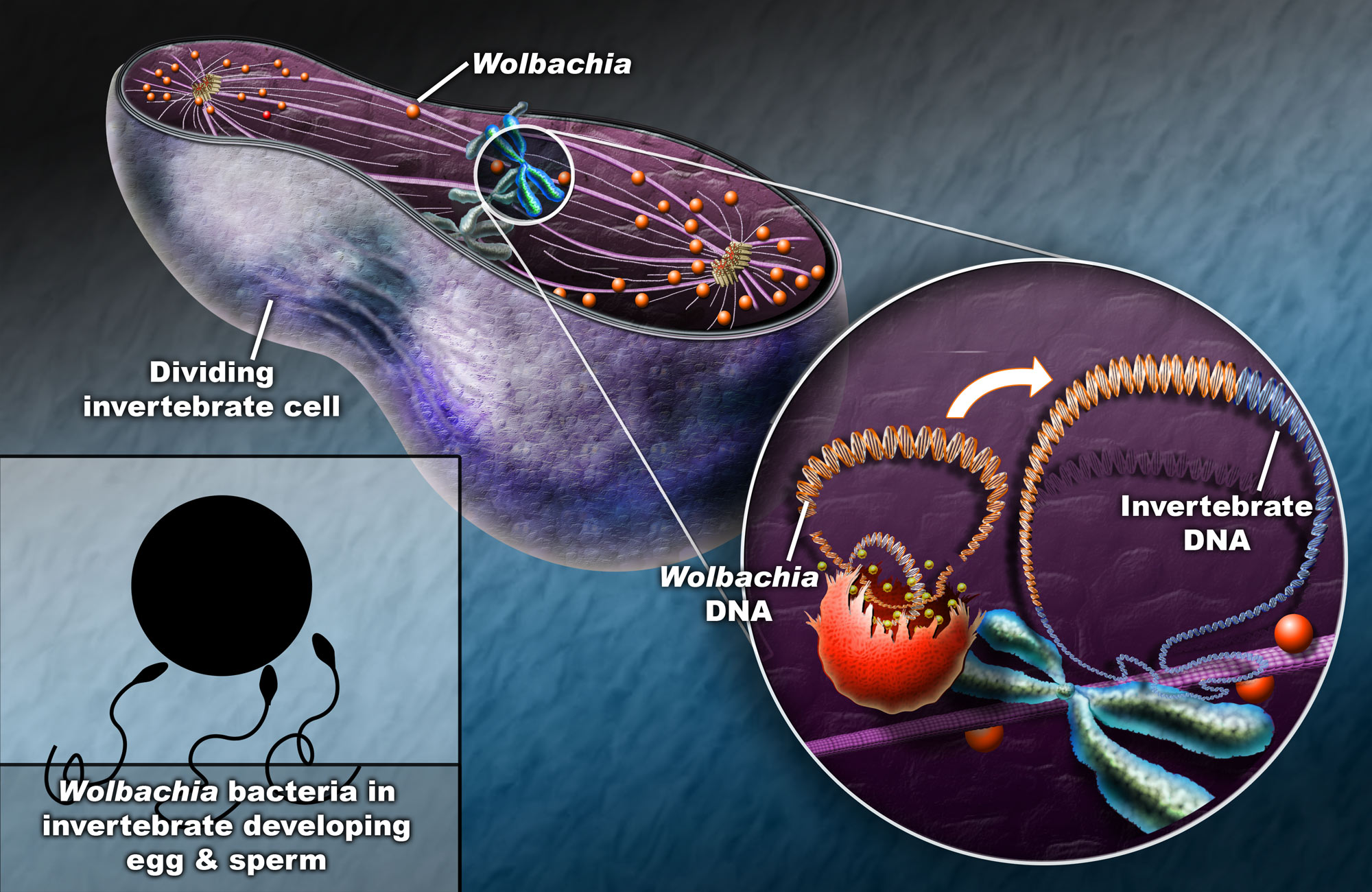Bacterial parasites are a lot more creative than we thought. It turns out one species, Wolbachia, can insert almost its entire genome into the genomes of members of one host species (a fly called Drosophila ananassae), and can insert parts of its genome into the genomes of members of several other host species.
"We've found at least one species where the parasite's entire or nearly entire genome has been absorbed and integrated into the host's," says Jack Werren of the University of Rochester, principle investigator of the study and a world-leading authority on the Wolbachia parasite. "The host's genes actually hold the coding information for a completely separate species."
In addition to finding virtually the entire Wolbachia's genome integrated into the fly genome, the research team also found stretches of Wolbachia DNA of various sizes integrated into the genomes of four other insect species and four nematode species. The research team corroborated their laboratory analyses by computational analyses that identified stretches of Wolbachia DNA in nine of 27 published insect genomes, suggesting that as many as one-third of invertebrate species have Wolbachia DNA in their genomes.

Werren says that several types of evidence indicate that gene transfers from Wolbachia to invertebrates occur frequently, including: 1) the team's discovery of Wolbachia DNA in so many randomly selected organisms; 2) the agreement between the team's laboratory analyses and computational analyses; and 3) the infection of approximately 70 percent of the world's terrestrial invertebrates by Wolbachia, which means that this parasite has had a virtually limitless number of opportunities to transfer its genes to its hosts.
It is not yet definitely known whether any transferred Wolbachia genes are functional. But Werren says that the frequent nature of Wolbachia lateral gene transfers indicates that this parasite has probably produced new functions in some animals. Moreover, the transfer of even a fragment of a Wolbachia genome would be significant if it contained even one functional gene.
NSF Program Director Matthew Kane says that the discovery of lateral gene transfer between Wolbachia and one of its insect hosts is not a fluke or a rare occurrence. "Insects are the most diverse of all groups of animals, and have established symbiosis with many different microbes," he says. "This study portends that horizontal gene transfer from microbe to host is probably a major force in evolution."
How does Wolbachia transfer its genes to other species? When the Wolbachia invades an organism, usually an insect, it eventually reaches the host's eggs or sperm. Once there, Wolbachia DNA is ensured passage to its host's offspring. But if the host cells accidentally pick up Wolbachia DNA as they routinely repair their damaged DNA, resulting genetic changes in the host cells may also be passed on to the host's offspring.
It was the Wolbachia's known ability to infect its hosts' reproductive organs together with an earlier discovery by other researchers of a Wolbachia genome incorporated into a beetle genome that initially inspired the research team to screen the genomes of invertebrates for Wolbachia genes. Early in the screening, they found evidence that some Wolbachia genes were fused to the genes of the fly, as if they were part of the same genome.
In an attempt to isolate the fly genes from the Wolbachia genes, the researchers killed all of the Wolbachia in a colony of fruit flies by feeding antibiotics to the flies. Follow-up testing of the fly DNA for Wolbachia DNA revealed, to their dismay, that it still tested positive for Wolbachia DNA. The researchers eventually discovered that they were detecting copies of the parasite's genome that remained in the fly genome, not the bacteria itself.
The researchers also verified that the Wolbachia genes were inherited like "normal" insect genes in the chromosomes. In addition, they confirmed that some of the genes were "transcribed" in uninfected flies, meaning that they contain copies of the gene sequence that could be used to make Wolbachia proteins.
The discovery of frequent lateral gene transfer has important implications for genome-sequencing projects in which bacterial DNA has typically been discarded as contamination. This study indicates that such discarded bacterial DNA may very well be part of the organism's genome, and may even carry functioning traits.
The discovery of frequent lateral gene transfer also has important implications for pest and disease control. If, for example, laterally transferred genes become vital to a disease-causing or transmitting host species, the transferred genes could serve as new disease-fighting targets.
In the future, the researchers hope to investigate whether other bacteria besides Wolbachia are engaging in frequent lateral gene transfer.
Although Wolbachia is not known to infect any vertebrates, such as humans, lateral gene transfers "have happened before in the distant past" notes Werren. "In our very own cells and those of nearly all plants and animals are mitochondria, special structures responsible for generating most of our cells' supply of chemical energy. These were once bacteria that lived inside cells, much like Wolbachia does today.
Like Wolbachia, mitochondria have passively exchanged DNA with their host cells. Wolbachia could follow in the path of mitochondria, eventually becoming a necessary cell component.
"In a way, Wolbachia could be the next mitochondria," says Werren. "A hundred million years from now, everyone may have a Wolbachia organelle."
"Well, not us," he laughs. "We'll be long gone, but Wolbachia will still be around."
Source: NSF






Comments